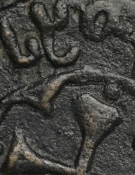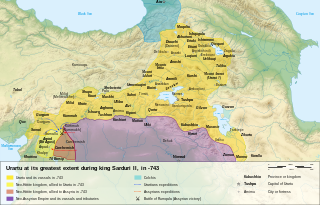Related Research Articles
The 9th century BC started the first day of 900 BC and ended the last day of 801 BC. It was a period of great change for several civilizations. In Africa, Carthage is founded by the Phoenicians. In Egypt, a severe flood covers the floor of Luxor temple, and years later, a civil war starts.

Shalmaneser III was king of the Neo-Assyrian Empire from the death of his father Ashurnasirpal II in 859 BC to his own death in 824 BC.
Shalmaneser IV was the king of the Neo-Assyrian Empire from 783 BC to his death in 773 BC. Shalmaneser was the son and successor of his predecessor, Adad-nirari III, and ruled during a period of Assyrian decline from which few sources survive. As such his reign, other than broad political developments, is poorly known. Shalmaneser's time was marked both by an increase in the power held by Assyrian officials relative to that of the king and Assyria's enemies growing increasingly powerful. Most of Shalmaneser's military efforts were spent warring against the Kingdom of Urartu in the north, which during this time was reaching the peak of its power.

Tabal was a Luwian-speaking Syro-Hittite state which existed in southeastern Anatolia in the Iron Age.

Diauehi (Georgian დიაოხი, Urartian Diauehi, Greek Taochoi, Armenian Tayk, possibly Assyrian Daiaeni) was a tribal union located in northeastern Anatolia, that was recorded in Assyrian and Urartian sources during the Iron Age. It is usually (though not always) identified with the earlier Daiaeni(Dayaeni), attested in the Yonjalu inscription of the Assyrian king Tiglath-Pileser I's third year (1118 BC) and in later records by Shalmaneser III (845 BC). While it is unknown what language(s) they spoke, they may have been speakers of a Kartvelian, Armenian, or Hurrian language.
Sien is one of the first historically-confirmed rulers of the Kingdom of Diaokhi, a confederation of proto-Georgian tribes. Ruling toward the end of the 12th century BCE, he is known from Assyrian sources describing the invasion of his kingdom by Tiglath-Pileser I in 1112 BCE.

Argishti I, was the sixth known king of Urartu, reigning from 786 BC to 764 BC. He founded the citadel of Erebuni in 782 BC, which is the present capital of Armenia, Yerevan. Alternate transliterations of the name include Argishtis, Argisti, Argišti, and Argishtish. Although the name is usually rendered as Argišti, some scholars argue that Argisti is the most likely pronunciation. This is due to the belief that the Urartians used the cuneiform symbol š to voice an s-sound, as opposed to representing the digraph sh.
Rusa I was a King of Urartu. He succeeded his father, king Sarduri II. His name is sometimes transliterated as Rusas or Rusha. He was known to Assyrians as Ursa and possibly Urzana. His birth name may have been Uedipri.
Nairi was the Akkadian name for a region inhabited by a particular group of tribal principalities in the Armenian Highlands, approximately spanning the area between modern Diyarbakır and Lake Van and the region west of Lake Urmia. Nairi has sometimes been equated with Nihriya, known from Mesopotamian, Hittite, and Urartian sources. However, its co-occurrence with Nihriya within a single text may argue against this.
Shupria or Shubria was an Armenian kingdom, known from Assyrian sources from the 13th century BC onward, in the Armenian Highlands, to the south-west of Lake Van, bordering Urartu. The capital was Ubbumu. The name Shupria is often regarded as derived from, or even synonymous with, the earlier kingdom of Subartu, mentioned in Mesopotamian records as early as the 3rd millennium BC. However, the Sumerians appear to have used the name Subartu to describe an area corresponding to Upper Mesopotamia and/or Assyria.
Sugunia was the first capital of Arame of Urartu. The city was mentioned in an inscription by the Assyrian king Shalmaneser III, who destroyed it in 858 BC.

The history of the Caucasus region may be divided by geography into the history of the North Caucasus (Ciscaucasia), historically in the sphere of influence of Scythia and of Southern Russia, and that of the South Caucasus in the sphere of influence of Persia, Anatolia, and Assyria.

Somkhiti was an ambiguous geographic term used in medieval and early modern Georgian historical sources to refer to Armenia on one hand and to the Armeno-Georgian marchlands along the river valleys of Debed and Khrami on the other hand. In the 18th century, Somkhiti was largely replaced with Somkheti as a Georgian exonym for Armenia, but it continued, for some time, to denote the frontier region which is currently divided between Lori, Armenia, and Kvemo Kartli, Georgia. This patch of land was sometimes referred to as "Georgian Armenia" in the 19th-century European sources.
Shamshi-ilu (Šamši-ilu) was an influential court dignitary and commander in chief (turtanu) of the Assyrian army who rose in high prominence.

Urartu was an Iron Age kingdom centered around Lake Van in the Armenian Highlands. It extended from the eastern bank of the upper Euphrates River to the western shores of Lake Urmia and from the mountains of northern Iraq to the Lesser Caucasus Mountains. The kingdom emerged in the mid-9th century BC and dominated the Armenian Highlands in the 8th and 7th centuries BC. Urartu frequently warred with Assyria and became, for a time, the most powerful state in the Near East. Weakened by constant conflict, it was eventually conquered by the Iranian Medes in the early 6th century BC. Archaeologically, it is noted for its large fortresses and sophisticated metalwork. Its kings left behind cuneiform inscriptions in the Urartian language, a member of the Hurro-Urartian language family. Since its re-discovery in the 19th century, Urartu, which is commonly believed to have been at least partially Armenian-speaking, has played a significant role in Armenian nationalism.

The kings of the United Kingdom of Israel, as well as those of its successor states and classical period kingdoms ruled by the Hasmonean dynasty and Herodian dynasty, are as follows:
The Assyrian conquest of Aram concerns the series of conquests of largely Aramean, Phoenician, Sutean and Neo-Hittite states in the Levant by the Neo-Assyrian Empire. This region was known as Eber-Nari and Aram during the Middle Assyrian Empire and the Neo-Assyrian Empire.

Kummuh was an Iron Age Neo-Hittite kingdom located on the west bank of the Upper Euphrates within the eastern loop of the river between Melid and Carchemish. Assyrian sources refer to both the land and its capital city by the same name. The city is identified with the classical-period Samosata, which has now been flooded under the waters of a newly built dam. Urartian sources refer to it as Kummaha. The name is also attested in at least one local royal inscription dating to the 8th century BCE. Other places that are mentioned in historical sources as lying within Kummuh are lands of Kištan and Halpi, and cities of Wita, Halpa, Parala, Sukiti and Sarita(?). Kummuh bordered the kingdoms of Melid to the north, Gurgum to the west and Carchemish to the south, while to the east it faced Assyria and later Urartu.

The timeline of ancient Assyria can be broken down into three main eras: the Old Assyrian period, Middle Assyrian Empire, and Neo-Assyrian Empire. Modern scholars typically also recognize an Early period preceding the Old Assyrian period and a post-imperial period succeeding the Neo-Assyrian period.
Utuphursi is the last known ruler of the kingdom of Diaokhi, a confederation of proto-Georgian tribes. His reign spanned over three decades during which he faced the expansionist policy of neighboring Urartu. He fought several battles against kings Menua and Argishti I in the first half of the 8th century BCE. His reign is documented through Urartian texts.
References
- 1 2 3 Chkhartishvili 2014, p. 213.
- ↑ Melikishvili 1970, p. 374.
- ↑ Suny 1994, p. 6.